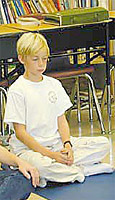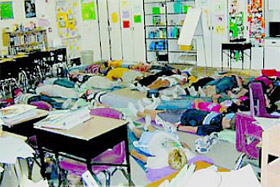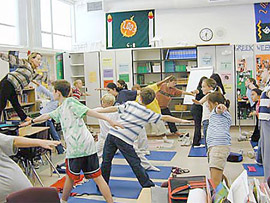Susan Brochin teaching yoga to her middle school students
To bloom where one is planted has become a big lesson for me. Rather than going out to find and create the right dharmic path for teaching yoga, it was there all along, so close that I could not even see it.
Without really having a plan, I began to share my yoga practice with students in my elementary school classroom. It is hard to remember how it began or why. But that’s jumping ahead of the story…
In addition to teaching at her school, she teaches at Ananda’s East West Bookshop, Ananda Palo Alto, and Fit from the Core fitness center.
What led me to return to my Hatha Yoga practice in 1996 after more than twenty years of partial commitment was the stress from teaching at Oak Knoll elementary school in the Menlo Park City School District. (Menlo Park is next to Palo Alto, in the north end of Silicon Valley, about 45 minutes south of San Francisco.) Little did I realize that the yoga that I took to heal myself would become an instrument for opening and helping to alleviate the stress in the lives of children.
In the summer of 2000, I graduated from the Ananda Yoga Teacher Training program, ready and eager to teach yoga. My yoga teacher at East-West Books in Mountain View, Premdas Ghirla, had left recently to cook at the Ananda Center in Italy, so I began to teach the class where I had been a student for years. It was a wonderful balance for the days I spent as an upper elementary school teacher.
Practicing Yoga with My Students
That same year, some of my fifth grade students learned that I enjoyed yoga, and during lunch hour, many of them stayed inside to practice with me. It just simply, magnetically, and energetically took hold with them.
In Ananda Yoga® we refer often to moving the energy up the spine. We teach it, consciously increasing the students’ awareness of what is happening inside. Children, like all of us, are pure energy. The difference is that, in most of them, their energy is clear, expressive, and outward. Intuitively, they understand what yoga is about, but with kids younger than mid-teens, the concept of subtle energy is too abstract.
So, what I did is just watch them transform through their practices. The joy and willingness that they put into their postures were immediately obvious. Many spent several lunch hours a week just playing with the postures and using it as their way to connect with each other, and with me.
One thing led to another. Never having choreographed before, I prayed for guidance, and with several dance students’ help, we created a “yoga dance” for the fifth grade performance of The Ramayana.
It was a huge lesson in having confidence in the wisdom of these young souls and in letting go of needing to be in charge. Twelve students — six boys and six girls — volunteered to perform, tirelessly working through their lunch hours. They pulled off a magnificent performance, ending gracefully with a bow and “Namaste” to the audience. We translated, as best we could, the meaning of that powerful word to over 300 people.
During the summer of 2001, I attended the “Sharing Yoga with Children” program at The Expanding Light Retreat. This experience — taught by Nitai Deranja, the founder of the Living Wisdom School at Ananda Village — was transformational, joyful, and lots of fun. Being a certificate- and degree-oriented person, I now at last felt trained and open to finding more avenues for continuing to develop this aspect of teaching.
Friday Afternoon Classroom Yoga
Armed with many new techniques from Nitai’s program, I committed to an every other-week, 45-minute yoga session with my fifth graders. For props, we used all of my old towels as mats and $1 neckties from the Goodwill Thrift Store.
The sessions began first on Thursdays, and then changed to Friday afternoons, right before the weekend (traditionally a challenging hour for teachers). At first, I was unsure about having 24 students in such a small room, feet in each other’s faces. I wondered about the more rowdy students and was concerned about their behavior, but despite all of that, I persisted. The integrity of the practice, the energy behind it, and the possibility for transformation were bigger than my doubts.
We began with the breath. One of their favorite techniques was Nadi Shodhanam. With children it is so easy to feel the silence and calm in the room. But that didn’t happen right away. They giggled at first, and typical of this age, they thought everyone was looking at them. Soon, however, the room vibrated with their silence. They felt it, too, and we discussed how this technique helps to balance the right and left sides of the brain.
Some days we began with the Energization Exercises. Yogananda initially developed these for his school for boys around the same age in Ranchi, India; it seemed natural to use them in this school setting. We did an abbreviated form of the series, and they responded with great enthusiasm. The most popular was always the light pounding of fists on the crown of the head, which they termed “brain thumping.” We combined the exercises with affirmations, as in the Superconscious Living Exercises.
I gave them the freedom to make up some of their own, and the one they made up for brain thumping was, “Wake up, brain!” Before standardized testing in the spring, we “thumped our brains” again. The actual effect of this we will never know, but I’m confident that they were at least more relaxed during the testing.
Many of the postures were huge hits. They especially enjoyed Vrikasana and Virabhadrasana. Sometimes it felt necessary to depart from the seriousness of an adult’s perspective on yoga practice in order to meet the kids on their own levels of understanding and interest. For example, when we went into Virabhadrasana, we jumped up with both feet, then as we came down, we made a loud warrior sound as our affirmation.
The Outdoor Education Surprise
In March of 2002 we were getting ready to go on our annual visit to “Outdoor Ed.”, a five-day trip to the redwoods in the Santa Cruz Mountains south of San Jose. One of the most challenging times of the day for the teacher chaperones has been “teacher time.”
One can only imagine being given a class of energetic fifth graders (who have not seen me in a teacher role in several days, and have not been together as a class) from 4:30 P.M. until 5:45 P.M. Everyone was exhausted, and not particularly eager to regroup.
In past years, I had given students a workbook of activities and simply had them work quietly after bribing them with candy. Not last year — we did yoga! Not only did they do yoga, but they were lying down in the baseball field in Savasana while kick-balls from other classes whizzed by.
They were calm, strong and steady. Bones, muscles, movement were all surrendered to peace. It was incredible. Not only were they totally into their practice, but also seemed unaware of their peers and not at all self-conscious — very unusual for children that age!
A New School, A New Direction
The next year, I moved to Hillview Middle School, just down the street in the same school district. There, the 45- minute yoga session became history as life grew more academic. Nevertheless, an opportunity for a yoga club eventually surfaced, and several students from my class came. At first, participation in the club held steady at about 7—8 students.

A boy named Ted was one of those most affected by the practice of Ananda Yoga®. He agreed to write about how the experience of yoga has changed his life.
Recently, the local school district has become very interested in the well being of the whole child. As a result, sixth graders (the newest kids in middle school) now have a short “Introduction to Sixth Grade” course. In this class, many aspects of their adjustment to Middle School are explored, including an awareness of the impact of stress on their lives. I was asked to give a yoga demonstration in two of the sections.
We had a wonderful time doing some “chair yoga,” again with men’s neckties as stand-in props for straps. Just last week there were over 26 students in the club. They were crowded into one average-sized classroom.
Students kept dropping in, unconcerned that there were no props left. They just seemed to want to do yoga. I had to teach on top of a desk so they could all see the demonstration, and I could get an overview of how they were doing.
A couple of their favorite asana affirmations are “I am calm, I am poised” (Vrikasana) and the one for savasana (“Bones, muscles, movement …”). They really enjoy them, and they go very deep in Savasana. In fact, this group is so positive and enthusiastic that they love everything we do.
Ted continues to be one of our stars. He shone in his demonstration of Savasana, making especially sure that the palms were up and the feet relaxed.
New Horizons
The students continue to open and learn more about themselves. As you may know, many recent research studies have demonstrated how yoga can assist students with their learning and increase their self-esteem.
(Among others, see “Yoga, Physical Education, and Self-Esteem: Off the Court and Onto the Mat for Mental Health” from the Californian Journal of Health Promotion.)
My friend and colleague, Sarah Westfall, the physical education teacher at my old elementary school, recently used these many research findings to convince our local district to fund a new project: “Otter Yogis, Teaching Yoga to and for Children” (Oak Knoll School’s mascot is the otter).
This grant will enable us to train teachers in teaching yoga to children. The teachers are kindergarten through fifth grade classroom teachers and specialists. There are 31+ teachers signed up from Oak Knoll School. I am in the process of preparing eight 75-minute sessions to help them bring these ideas and practices back into the classroom — and perhaps even begin a yoga practice themselves.
Eight classes is not a lot, but if they do their reading (which will include introductions to the postures, to pranayama, to Savasana, to yoga for kids), they can get a lot out of it. I feel that after these sessions, the teachers will have enough background so they can lead simple, kid-level Ananda Yoga® routines (with postures and pranayama).

“Bones, muscles, movement, I surrender now …” Deep relaxation is a real favorite among the students.
The first session is scheduled for mid-December — an Ananda Yoga session, affirmations and all. After a hiatus for the holidays, the sessions will continue into March.
Week 2 will also include the Superconscious Living Exercises. In subsequent sessions, we will take apart the pieces of the first session, practice more pranayama techniques, and learn about doing and teaching simple postures to kids. As things unfold, we will repeat and integrate what we did in previous weeks. We hope that by April, all of the teachers will begin to use the techniques in some way in their classrooms.
A lot of the fun has been in the planning. I am doing just one week at a time, because I really want it to be well planned, including hand-outs etc. The text is The Idiot’s Guide to Yoga for Kids (I don’t like the name, but I love the book), and there is a wonderful deck of cards called The Kids’ Yoga Deck. [Another book is Yoga Games for Children. —Editor] The school district is giving us over $5,000 for a set of books for each teacher. It’s almost mind-boggling that they are supporting us in this way. Who knows where it will go?
This is a an open and growing field for anyone who has had experience with children or simply enjoys the energy of these young souls. I feel blessed to be working with them both as a classroom teacher and as a yoga buddy.

